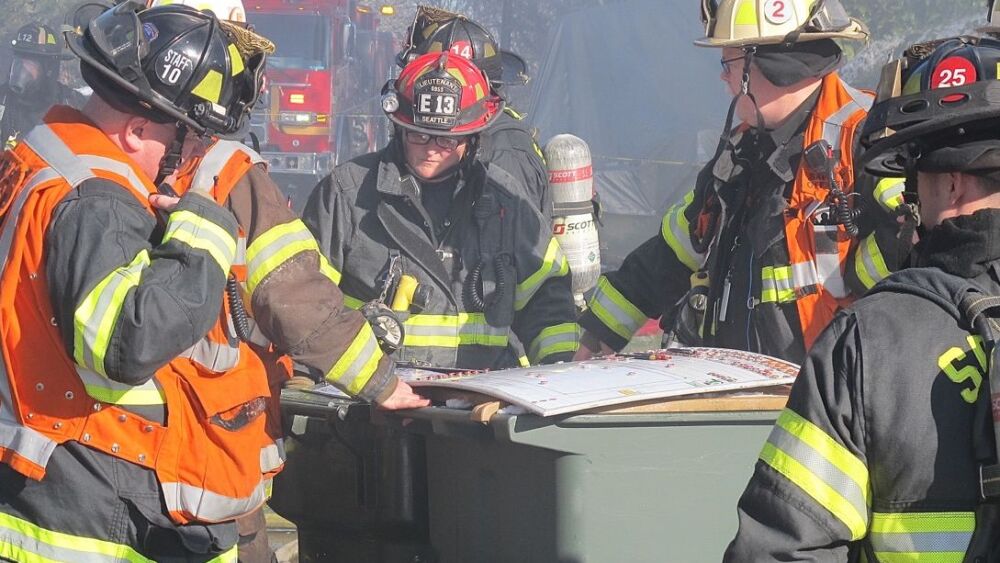The fire service is full of problems. Problems abound whether good times or bad, high or low morale, EMS or not; they will be there.
How we deal with the difficulties and maneuver in a changing environment will either improve or worsen our departments.
I don’t know if this was psychologist Jordan B. Peterson’s original thought or if he was quoting another, but I remember him saying that every decision we make or action we take moves us a little closer to heaven or hell. That representation may be a bit extreme, but you get the picture.
Unfortunately, the fire service is sitting in purgatory, at least from a decision-making standpoint. And, I believe that the main contributor is the centralized command of our fire departments.
The problem with centralized fire department systems
Every fire department, big or small, has a hierarchical structure. And, I assume, every firefighter has heard the term span of control. The span of control, in a nutshell, says you can’t effectively manage more than 3-7 people. So a fire chief managing 1,000 folks is an impossible task.
If you are leading a department of that size, just trying to manage the 20-30 battalion chiefs is impractical, nevermind deciding what T-shirts individual stations can wear.
And if you’re the fire chief who’s deciding what T-shirt a company can wear, then you either aren’t empowering your station leaders to make decisions, or you promoted the wrong people. You are removing the frontline leaders’ responsibility for even the most arbitrary of decisions and demeaning their capabilities.
I wouldn’t say I like comparing the fire service to the Soviet Union, but you’d think we would have learned our lesson about extreme centralization: It doesn’t work.
Thriving economies, businesses, governments, fire departments, etc., need a bottom-up system that allows for rapid trial and error to be effective. Unfortunately, a bottom-up, or decentralized, system is the opposite of how decisions get made in the fire service.
Allow this sequence of events to describe the process:
- A lightbulb goes off.
- A lowly firefighter formulates an idea.
- They bring the idea to their lieutenant.
- Lieutenant says, “Sounds great. Let’s talk to the captain.”
- Captain says, “Sounds good. Let’s talk to the battalion chief.”
- Battalion chief says, “Sounds interesting. Let’s talk to the division chief.”
- Division chief says, “Sounds OK. Let’s talk to the operations chief.”
- Operations chief says, “I don’t know. Let’s talk to the fire chief.”
- The fire chief says, “Let’s talk to HR.”
- HR says, “What did everybody else say?”
This process probably takes about three months and frustrates, demotivates and discourages frontline leaders.
So how can we do better?
How a decentralized command system works at the fire department
If you are a fan of Jocko Willink, a retired Navy SEAL, you have no doubt heard the term “decentralized command.” It’is one of four laws of combat that he wrote about, along with Leif Babin, in Extreme Ownership: How U.S. Navy Seals Lead and Win.
Willink writes: “With SEAL Teams – just as with any team – there are leaders who try to take on too much themselves. When this occurs, operations can quickly dissolve into chaos. The fix is to empower frontline leaders through Decentralized Command and ensure they are running their teams to support the overall mission, without micromanagement from the top.”
He goes on to describe the issues around a centralized command structure: “There are, likewise, other senior leaders who are so far removed from the troops executing on the frontline that they become ineffective. These leaders might give the appearance of control, but they actually have no idea what their troops are doing and cannot effectively direct their teams. We call this trait ‘battlefield aloofness.’ This attitude creates a significant disconnect between leadership and the troops, and such a leader’s team will struggle to effectively accomplish their mission.”
The fire chief has to establish their Commander’s Intent (CI), or ultimate goal, and communicate this to their direct subordinates. Once they understand the Commander’s Intent, they can align their behaviors to accomplish this while creating the Commander’s Intent for their particular division.
As this moves its way down the chain of command, the Commander’s Intent should get more and more tactical while leaving room to cover and move if necessary.
If the Commander’s Intent is communicated and understood, you can empower your frontline leaders to make decisions that align with the strategic goal. This is more effective and efficient than traversing the chain of command for every decision.
As a leader, if your subordinates are asking “why,” then you likely have not communicated your Commander’s Intent thoroughly. Once they understand it, you have to give them the operational freedom to make decisions and lead. If this is implemented correctly, frequently, as a leader, you will find yourself following. Remember, just because you are in a leadership position does not mean you have the best solution to every problem.
Empower your team
When one of your subordinate chiefs, captains, lieutenants or firefighters are working toward implementing a solution, please don’t take that project over. Empower them to continue and give them the support that they need.
If we can adopt this mentality, eventually we will all train ourselves out of a job because the person below you will be doing it. That might seem like a bad thing, but now you have given yourself the freedom to focus on the most important thing that moves your department forward instead of trying to do everyone else’s job.
Editor’s Note: Do you agree with the author’s approach to command? Share your thoughts in the comments below.













